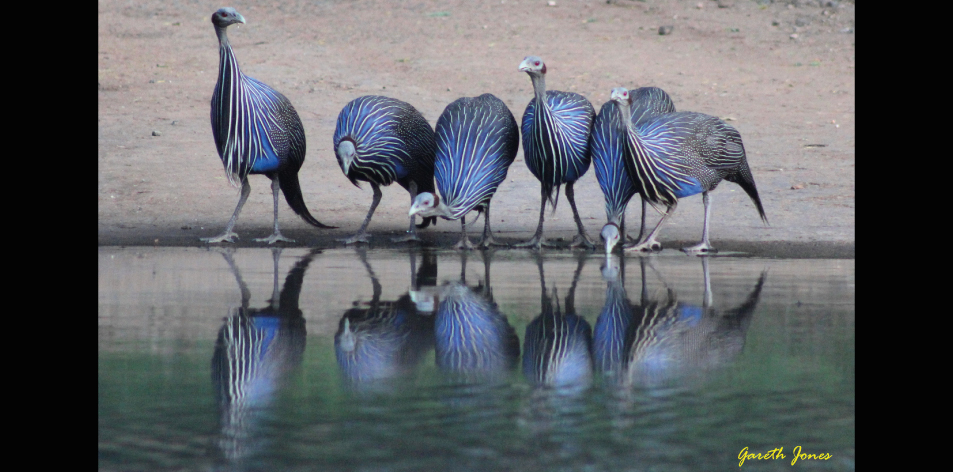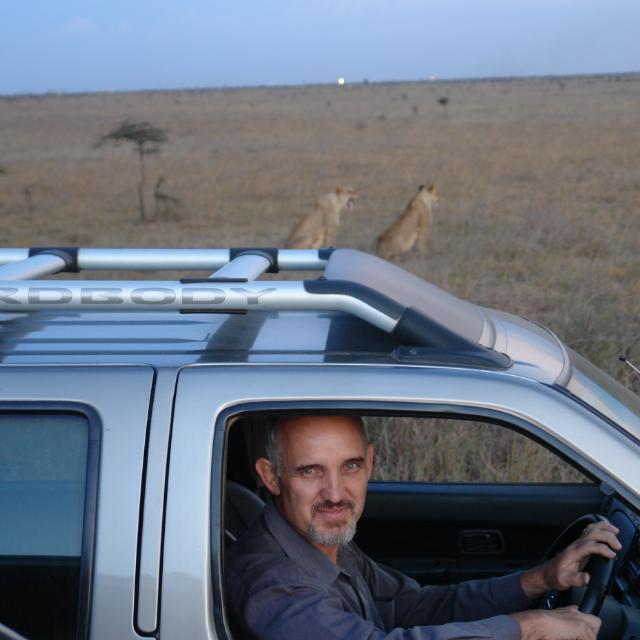
Magnificent Meru!! – Article by Gareth Jones
MERU NATIONAL PARK: ‘MAGNIFICENT MERU’ – By GARETH JONES
The alarm clock buzzed at 04h00, we rapidly awoke and packed a few remaining items into our car and left Nairobi just after 05H00. I always try to plan safari trips out of Nairobi to leave very early in the morning to avoid the early morning traffic “jam”. With the new Thika highway, we progressed quite well, and soon we began to feel that we were actually on leave. We were excited to be on our way to the Meru National Park after many weeks of planning. Slowly it began to get light, I had decided to travel to Meru via Nanyuki, the other scenic option being via Embu, both routes circle around Mount Kenya to get to Meru town.
After nearly 3 hours of travelling, we arrived at Barneys restaurant at the small Airport just outside Nanyuki and enjoyed a great breakfast with coffee. We continued along the scenic route past Nanyuki, as we approached Timau the clouds opened and revealed a beautiful view of Mount Kenya. We continued to Meru town and then turned off to complete the final 67 km along the C91 road to the Meru National Park entrance Murera gate (take care to watch for the turnoff sign – left turn. On the C91 Meru-Makutano-Maua highway, the turnoff to Meru National Park is just after Maili Tatu market, at a place popularly known as “Farm”. There is a bend on the road and some speed bumps before the junction on the left to the E817. You will see the signage for Meru National Park and Ikweta Safari Camp. The road is tarred to the Murera main gate).
We arrived at the Murera gate after nearly 7 hours of leisurely travelling at about 13h00 just as it was getting quite hot. Total distance was 345 km (the route via Embu is slightly shorter at 310km with more hilly winding scenic roads). Thankfully we paid cash at resident rates and drove into the park along the main road to the park’s Head Quarters. Some weeks before I booked the family Kinna banda at the Bwatherongi campsite (this can be done through KWS –HQ offices near the Nairobi National Park main gate). The campsite is located near the park Head Quarters next to a stream with a swimming pool, the banda accommodation is basic (we tend to bring our own bedding). There are also no facilities here so bringing enough drinking water is critical, plus well-planned meal plans and cold storage boxes as there is no fridge. However, we enjoy “roughing” it a bit as it is almost like camping except we sleep in a banda with a small lounge and basic shower and toilet. Protection against insects is highly recommended including taking anti-malaria tablets.
After unpacking and resting during the heat of the day, we cooled down at the swimming pool and prepared for the first of a number of game drives. It is important when self-driving to have a good detailed map of the park, and be observant to the condition of the roads, especially during the wet season. Many of the roads are not drivable in a normal saloon car, therefore a 4×4 vehicle with high clearance is recommended to ensure avoiding disappointment in not being able to see certain parts of the park.
One thing we do like about Meru National Park is the incredible feeling of remoteness, you might almost feel as if you are the only people in the park at times. Naturally, early mornings and late afternoons are the best times for game drives. The park is not huge at 870 sq km and is virtually on the equator, however, it is also part of the greater Meru conservation area that includes Kora National Reserve. The park has a wide range of wild animals including the African elephant, buffalo, lion, leopard, cheetah, striped hyena, eastern black rhinoceros, southern white rhinoceros, Grévy’s zebra, gerenuk, reticulated giraffe , fringe-eared oryx , eland , lesser kudu, various gazelles, the tiny delightful dik-dik and hippopotamus in certain pools of the rivers. We also had a rare sighting of a caracal as we returned from a game drive late in the afternoon. The birdlife is abundant with over 450 species being recorded at various times of the year, including special species like the vulturine guineafowl, Somali ostrich and Pel’s fishing owl, amongst others. It is very rewarding to find a quiet place along one of the river drives and watch wildlife. The landscape and vegetation of Meru include bushveld and a series of at least 13 life-giving rivers with dense riverine forests of Doum and Raffia palm, including the Tana River. On a clear crisp morning or late afternoon, it is sometimes possible to enjoy a view of Mount Kenya in the distance. Meru is truly a magnificent wilderness that mere words cannot express, only those who have experienced this wonderful place will begin to appreciate the awesome creation that God put there.
Between the years 2000 and 2005, the Kenya Wildlife Service, helped by the International Fund for Animal Welfare (IFAW), restored Meru National Park from near ruin to one of the most promising tourist destinations in Eastern Africa, solving the parks poaching problem. IFAW donated $1.25 million to this major restoration project and with this money aided in improving the basic infrastructure and provided essential equipment and vehicles for law enforcement activities.
Meru was one of the two areas in which conservationists George Adamson and Joy Adamson raised Elsa the Lioness made famous in the best selling book and award-winning movie ‘Born Free’. Elsa the Lioness is buried in this park and part of Joy’s ashes were scattered on her gravesite. Elsa’s grave is at the southern end of the park, off the southern bank of the Ura River. Today there is a well-known lodge in the park called Elsa’s Kopje. Other accommodations include Rhino River Camp and Ikweta Safari Camp near the main gate, and Leopard Rock lodge in the park, there are also fully furnished KWS bandas at Murera main gate and Kinna bandas and Bwatherongi campsite.
After five wonderful days in the park, it was time to return to Nairobi. We went for one last early morning drive and saw a huge herd of elephants crossing the road as we drove towards the main gate. The return route we decided on was the same as the initial route. Just past Nanyuki and just before Noru Moro is the well-known Trout Tree restaurant, that is the perfect stopping place for a good meal and a stretch of the legs. The restaurant is built into a giant fig tree on a trout farm in a forest where at times colobus monkeys sit above the guests as they dine. We left the Trout Tree restaurant and cruised back home with no incident except a bit of late afternoon traffic.
Thinking back on magnificent Meru now, I already want to return in the near future, if possible. Meru National Park is indeed a really wonderful wilderness, a tonic “Dawa” for weary souls to rest and recover from the frantic ways of the world we live in.
The park is open daily from 08h00 to 17h00.
Gallery
Sorry, the comment form is closed at this time.



Steve Daly
We have visited Meru twice, staying at Elsa’s Kopje. Of all the parks we have visited in Kenya, Meru is the least visited and is an oasis of tranquillity. As you say, you can go all day without seeing another vehicle – a rare thing compared with most of the other Kenyan parks and reserves. It is indeed a hidden gem amongst Kenya’s jewels. Yes it is remote, and the long drive surely puts many people off visiting. We fly in from Wilson Airport, which I know is the expensive way of doing it and maybe out of reach of many people, but it does beat that long drive.
I am currently chronicling our various Kenyan safari adventures over the past ten years, and have just published on relating to our first visit to Meru.